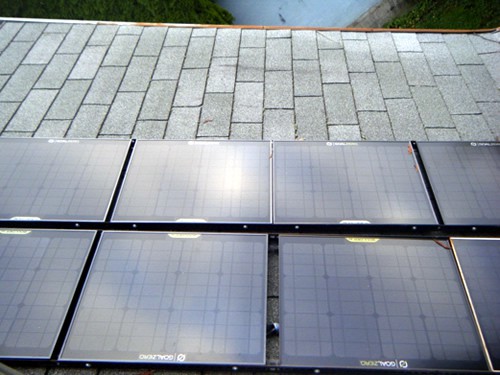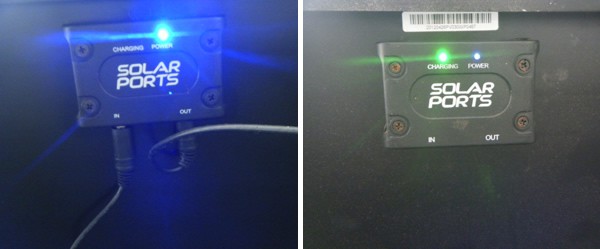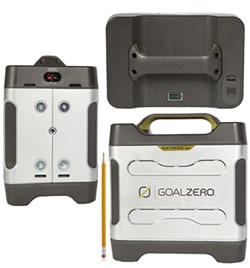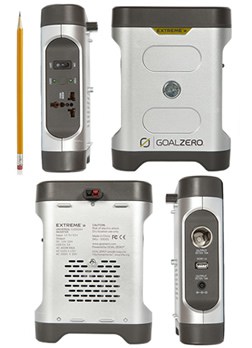Overview
 As a resident of the coastal Pacific Northwest, I set out to set up a backup power source never thinking I’d be a candidate to discuss the pros and cons of such a setup. After receiving a strong reference from Jason W., I contacted Denis Korn of Prepare Direct. I checked his products and blog and came across the Extreme 350 Base Camp kit manufactured by GoalZero. Because of my particular situation (living in a fairly urban environment in the PNW) I didn’t want to purchase a large system that was going to be tied to the grid, for several reasons:
As a resident of the coastal Pacific Northwest, I set out to set up a backup power source never thinking I’d be a candidate to discuss the pros and cons of such a setup. After receiving a strong reference from Jason W., I contacted Denis Korn of Prepare Direct. I checked his products and blog and came across the Extreme 350 Base Camp kit manufactured by GoalZero. Because of my particular situation (living in a fairly urban environment in the PNW) I didn’t want to purchase a large system that was going to be tied to the grid, for several reasons:
- I didn’t think it’d generate enough energy to make a difference.
- A larger system would be a ‘permanent’ addition to my home, which I don’t intend to stay in for long.
- If I ever had to leave quickly, I wanted to be able to take a “renewable” energy source with me.
I called Denis, told him my situation, and he gave a very practical assessment of the capabilities of this kit and gave me an overview of what it was intended to do:
This equipment was designed to meet the needs of adventurers, relief workers, remote expeditions, and for emergency power for small homes or cabins.
So, first of all, lets discuss what this kit will not do.
I recall asking Mike Pilat a few years back the following question: “What’s the most efficient alternative energy?” And he answered with “Use less energy.”
With that in mind, you’re not going to keep your refrigerator going; you won’t be cooking on your oven, or using your microwave. Don’t expect to vacuum your floors or wash your clothes. Don’t expect to run an electric welder.
Now, on to the specifics of my setup.
I bought the Extreme 350 Base Camp Kit, to which I added 4 additional panels to help charge the two included Extreme 350 battery packs, for a total of 700 watts of energy storage. The panels themselves are ruggedized, framed in lightweight aluminum and covered in tempered glass that makes them fully waterproof. This makes for a product that’s rugged enough for expeditions where they’re being set up and torn down continually, but tough enough to withstand light debris if they’re set up on a rooftop. Another critical feature of the panels is how they connect to one another and the Extreme 350 batteries.
Each panel has a small chaining port which has an input and output rated for the 30W monocrystalline cells. Each panel is connected via a male or female end on a standardized cable (which also hooks directly to the battery) so this allows easy, “idiot proof” assembly. Each chaining port has two diodes, one green, indicating that there is a charge being absorbed, and one blue, indicating that there is power being produced. This makes it pretty easy to determine if you’re actually getting energy to your batteries and helps with troubleshooting.

Charge Time and Batteries
The easy math is that for one panel to charge one 350W Battery, it will take 12 hours. For two panels, it will take ~8 hours, for three panels it will take 4, and for four panels, it will take 2 hours of direct sunlight at an ideal angle. GoalZero specifies the converting efficiency at 17-18%, with commercial standard panels rating between 14%-19%. Each panel comes with a connector cable, so adding panels is easy and the setup is highly modular – you can use as many or as few panels as you need. So if, for example, you wanted to take your array camping, but didn’t need the whole thing, you could take a few panels and one battery, and have portable, renewable energy, while your system at home continued to charge.
With this in mind, the 8 panels require 4 hours to charge the (2) 350W batteries, and from my experience, this has been a pretty useful guide in determining and budgeting energy, and a pretty reliable method of calculating a rough amount of incoming energy.
For this reason, the larger array is well suited to the Northwest where your hours of sunlight may be relatively low – you’re going to want to gather it as quickly as possible. If you’re in Arizona, a different size array and perhaps panels that collect more energy (higher Wattage) would be a better fit. This is something to keep in mind.
Each battery has a display indicating both a visual and rough numeric estimate of your current charge. As the device charges, the “battery” display will move, indicating that energy is flowing into the battery. It moves in reverse as energy is removed from the system. Pictured to the right is a fully charged E350 battery and its size comparison.
In addition to the ease of connecting to the panels, the E350 batteries can also be linked to one another (with a maximum of 4 batteries, for a total of 1400W) via a cable provided. At this point, I’d like to mention that each battery also comes with an A/C cord which you can use to charge the batteries from your existing power infrastructure. So even if you don’t have a solar package put together, you can still have some backup power. I like this, as in my region, we do have times when our sunshine is very limited.
Ratios and use
The ratio of panels to battery was said to be ideal at 4/1 – so 120W of incoming energy per each 350W battery. I decided to go with 8 panels and two batteries and each Extreme 350 battery came with a connecting cable to “daisy chain” the batteries together for greater efficiency and a deeper energy well. At present, I generate more energy than I can use, and am now regretting not being able to tie the system to the grid.

A quick word on my setup – as much as I hate to admit this, it’s still a lot more convenient to use “grid” powered lights and outlets. This is something to consider when you assemble your own system. If you put it upstairs in a room you rarely go in to, you won’t use the energy you’re capturing as often. I’d recommend putting the batteries and inverter somewhere you can access them readily. This will benefit you in two ways:
- You can make the most use of the ‘free’ energy you’re getting, as you get it, and
- In an emergency, your energy source will be easier to access.
Ideally, I’d like to double this entire setup, and have 16 panels and (4) E350 batteries to work with, and arrange one array for my shop, and keep the one on my home for backup power and lighting.
Inverter
The inverter supplied is GoalZero’s “Universal Inverter”, or UI. It is mounted to the Extreme 350 battery; it is here that the panels ‘connect’ to the batteries, and the inverter can then supply 12 Volts to car and USB adaptors, and can be switched between 110 and 220.
The power can be turned on or off via a master switch, and can power devices using up to 400W.
Energy Use
Charging batteries for use around the house is pretty energy sparse. I can discharge less than 10% of one battery to charge several batteries at a time. Power tools, such as rechargeable drills, will drain about 40% of one battery, which means it’ll cost you about 5 hours of sunlight, and it’ll take about 5 hours to completely charge. My HAM Radio can be charged in ~3-4 hours and requires about 25-30% as well.
The LED backup lighting that comes with the package is extremely efficient, and so far, I haven’t been able to deplete the batteries with moderate use of these lights. I read that they can be powered for ~13 hours off one battery, and there are four included with the Base Camp kit.
A quick word on these LED lights – they’re very bright and are extremely easy to hook up. I attached carriage hooks throughout my home that I can quickly snap the LED lights on to. The lights are daisy-chained, so some thought must be put into the overall setup, but each light is actuated individually and provides an approximate 250 lumens – enough to power stand-alone lighting, and more than enough to supplement candles and lanterns.
Overall Impression
This setup has shown me that I’d really like to have a grid tie system. Even if it’s not much, it’d offset your energy spending a bit and allow you to gain some benefit from however much extra energy you capture. With that quick detail out of the way, I am very pleased with the performance, quality, ease of use, and service provided by this setup. GoalZero and PrepareDirect have repeatedly impressed me, and I have to take a moment and make a few comments on PrepareDirect.
Denis Korn, the proprietor of PrepareDirect was knowledgeable, and very involved with making sure I got exactly what I needed and at a competitive price. Denis followed up with me twice to make sure that the system had been delivered, replaced a faulty battery and refunded the shipping, and made sure I had all the information that I needed to make an informed decision based on my needs. I had not done business with Denis or PrepareDirect before, but I strongly believe that good business practices should be shared. Denis is a top-notch guy who’ll stand by his word and his products.
As for the GoalZero products, I had one battery (E350) that would not accept a charge. It was replaced quickly and I’ve had no problems for the last 4 months of use. The equipment is rugged, simple and efficient. I don’t think you could ask for anything more in a backup power system, and the price is very fair as well.
I opted to mount my panels to lengths of angle iron in order to keep the panels in runners of 4, for ease of movement that can be deconstructed quickly. All told, the project cost me around $2750, and while I may not be energy independent, I do have enough to get me by in an emergency.
Cheers,
~ Aaron Moyer
This is a companion discussion topic for the original entry at https://peakprosperity.com/building-resiliency-with-goalzero/
